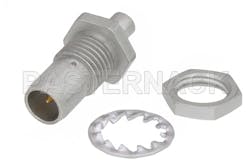BMA Connectors Push beyond Twist Tighten RF Connectors
In many applications, a threaded RF connection may be impractical, or even impossible. Some examples include panel, daughter cards, or inserts with many RF connections. In these cases the pitch between the connectors may necessarily be too small for a threaded nut, or the card/assembly may be inserted into a slot where there is no access. For these reasons, push-on type connectors were developed, which are also known as blind-mate connectors. A common blind-mate connector for military, aerospace, satcom, and radar is the Blind-mate A (BMA) connector developed in the 1980s.
Originally, this connector was designated with a trademark name, OSP, so these connectors are also often referred to as BMA or OSP connectors. The benefits of a BMA connector are that the mating, even with slight misalignment, can be done by simply inserting the jack into the plug with adequate pressure. Internal mechanical mechanisms then ensure the electrical connections are made securely and with proper alignment. This precision alignment allows for standard BMA connectors to operate to 22/26.5 GHz, with VSWR as low as 1.2:1 and typical insertion loss ~0.1 dB.
Due to the utility of BMA connectors, there are many variations for different installation types. These variations include BMA coaxial plug/jack connectors, BMA bulk connectors, BMA panel mount connectors, BMA PCB connectors, and screw-in hermetic connectors. The outer housing and mounting hardware for BMA connectors is often stainless steel, passivated stainless steel, and is sometimes gold plated stainless steel. The internal contacts for a BMA connector are often beryllium copper with gold plating, and the dielectric type is often PTFE.
As some BMA connectors have a “snap-on” feature, which is a mechanical slot or ridge that aids with retention, a BMA connector can be used in applications where forces would normally disconnect a slide-on style blind-mate connector. BMA connectors are also somewhat vibration and shock resistant, as the electrical connection within the connector is supported by 360 degree of contact.
The quality of construction and materials used on BMA connectors often enable these connectors to undergo several thousand mating cycles, which is often superior to other mechanical retention mechanisms. Hence, for test and measurement applications, and automated test applications, a BMA connector type can be a reliable connector interface that both speeds up connecting and disconnecting hardware, but also provides increased reliability and performance. Occasionally, BMA connectors are also used for high-speed digital signals, and power/signal applications, where high switching speeds and blind-mate connections are needed.
Find out more about Pasternack’s BMA Connectors here,
https://www.pasternack.com/pages/RF-Microwave-and-Millimeter-Wave-Products/bma-connectors.html
